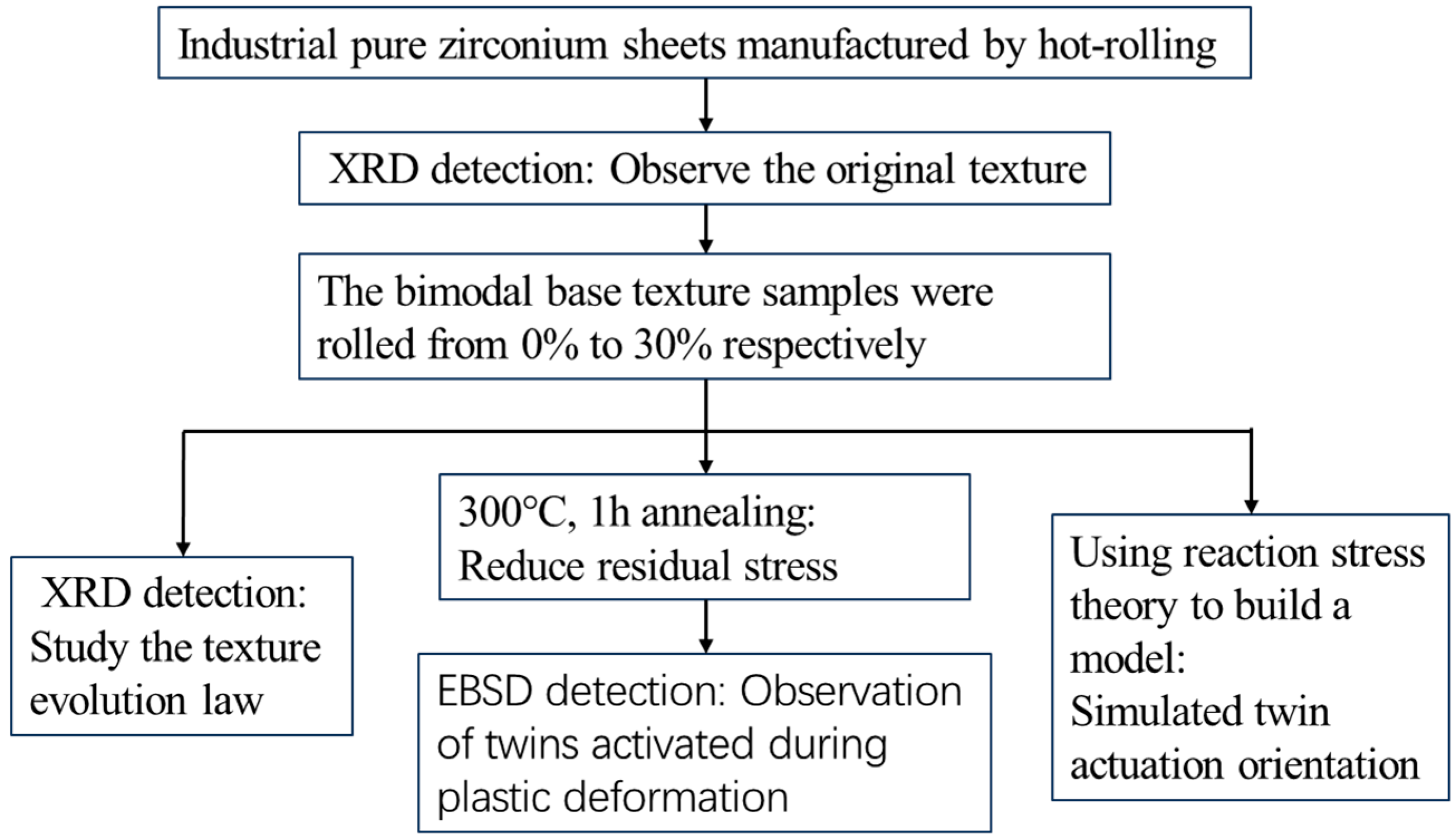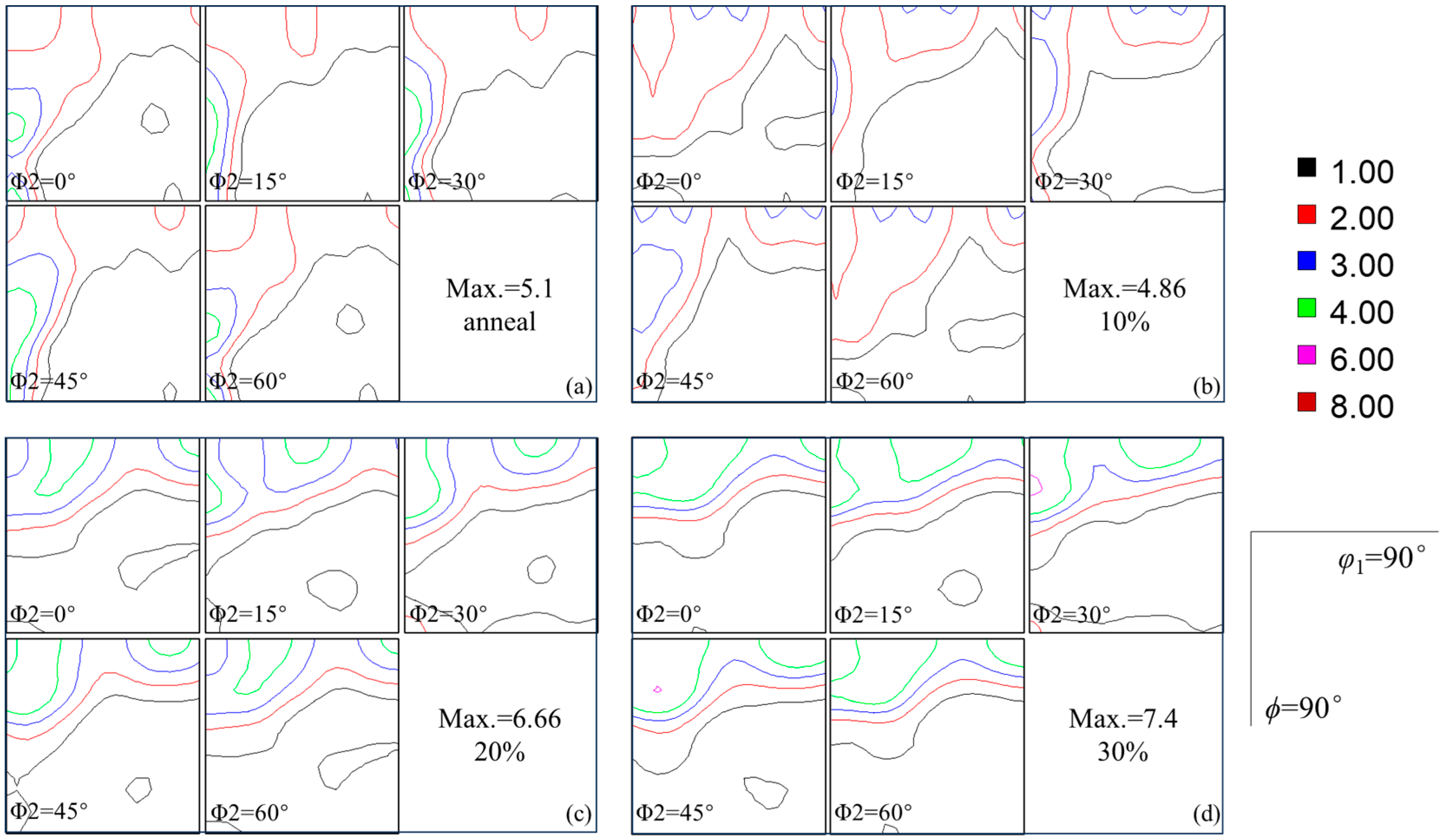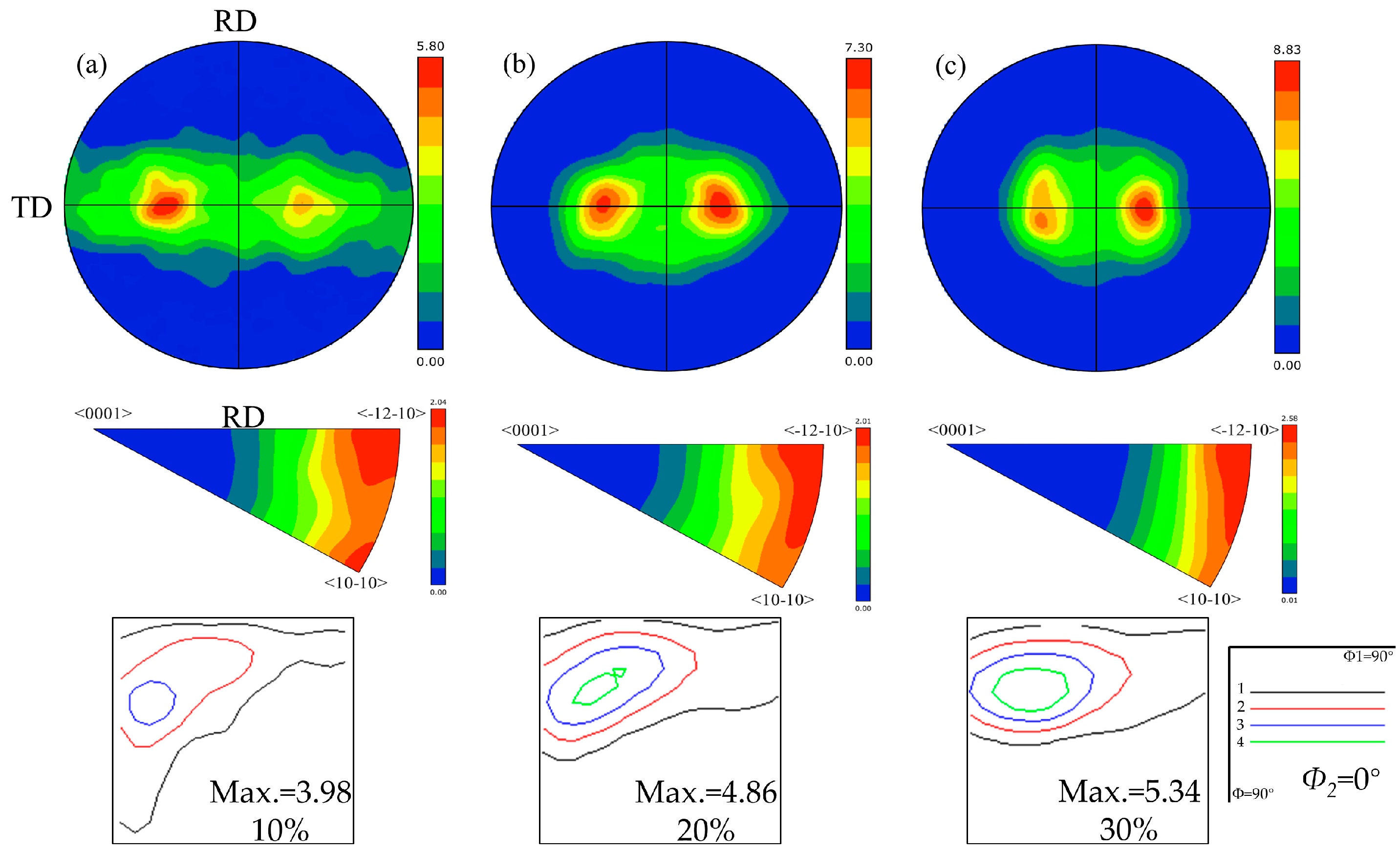Texture and Twinning Evolution of Cold-Rolled Industrial Pure Zirconium
Abstract
1. Introduction
2. Materials and Methods
2.1. Experiment
2.2. Simulation Method
3. Results and Discussion
3.1. Texture Evolution during Cold Rolling
3.2. Microstructure Characterization
3.3. Twinning Characteristics during Cold Rolling
4. Conclusions
- The initial hot-rolled zirconium plates had a diffuse texture deviating from the basal plane texture by 20°–90° along TD direction. Cold rolling develops a typical bimodal texture with a deviation of approximately 20° from the basal plane texture. This process facilitates a transformation in the preferred crystallographic orientations, shifting from the //RD to the //RD preferred orientations.
- Experimental characterization and simulation of the reaction stress model illustrate that T1 twins dominate in the early stage, contributing to the development of the {0001} orientation. Fine C2 extension twins can be observed evolving at the later stage of the cold-rolling process. Under severe deformation, low-angle grain boundaries propagate extensively, indicating that slip has become the predominant mechanism. The mechanism of the deformation of zirconium follows the trend of slip, twinning, local slip.
Author Contributions
Funding
Data Availability Statement
Conflicts of Interest
References
- Long, J.; Zhang, L.J.; Ning, J.; Na, S.J. Instantaneous phenomena during the pulsed fiber laser welding of pure zirconium in a hyperbaric environment. Opt. Commun. 2021, 490, 126868. [Google Scholar] [CrossRef]
- Chen, X.; He, W.; Chen, W.; Liu, Q. Microstructures and mechanical properties of a commercial pure zirconium during rolling and annealing at different temperatures. Adv. Eng. Mater. 2021, 23, 2001039. [Google Scholar] [CrossRef]
- Yuan, F.; Zhang, Y.; Han, F.; Muhammad, A.; Guo, W.; Ren, J.; Liu, C.; Li, G. Incommensurate modulated structure in zirconium under three-point bending deformation. Mater. Lett. 2021, 295, 129830. [Google Scholar] [CrossRef]
- Zinkle, S.J.; Was, G.S. Materials challenges in nuclear energy. Acta Mater. 2013, 61, 735–758. [Google Scholar] [CrossRef]
- Bhattacharyya, D.; Cerreta, E.K.; McCabe, R.; Niewczas, M.; Gray, G.T., III; Misra, A.; Tome, C.N. Origin of dislocations within tensile and compressive twins in pure textured Zr. Acta Mater. 2009, 57, 305–315. [Google Scholar] [CrossRef]
- Tang, L.; Ding, S.; Qian, H.; Xie, Y.; Huo, Y. Fretting fatigue tests and crack initiation analysis on zircaloy tube specimens. Int. J. Fatigue 2014, 63, 154–161. [Google Scholar] [CrossRef]
- Guo, X.; Lu, J.; Lai, P.; Shen, Z.; Zhuang, W.; Han, Z.; Zhang, L.; Lozano-Perez, S. Understanding the fretting corrosion mechanism of zirconium alloy exposed to high temperature high pressure water. Corros. Sci. 2022, 202, 110300. [Google Scholar] [CrossRef]
- Yu, W.; Xiunan, Y.; Feng, T. Effect of Rolling Technology on Texture Orientation and Corrosion Performance of Zr-4 Zirconium Alloy Strips. Rare Met. Mater. Eng. 2012, 41, 2238–2242. [Google Scholar]
- Reddy, G.B.; Kapoor, R.; Sarkar, A. Dynamic phase transformation driven microstructure and texture development during deformation of Zr-2.5 wt.% Nb in α+ β phase field. Acta Mater. Lia 2023, 261, 119354. [Google Scholar] [CrossRef]
- Alvarez, M.V.; Buioli, C.; Santisteban, J.; Vizcaino, P. Evolution of texture and intergranular stresses of αZr and minority phases in Zr-2.5 Nb pressure tube through synchrotron X-ray diffraction. Acta Materia Lia 2024, 271, 119802. [Google Scholar] [CrossRef]
- Liu, Y.; Hyun-Gil, K.; Jeong-Yong, P.; Yong-Hwan, J. Evaluation of Microstructure and Texture Development in Zr-1.0Nb Sheet during Cold-Rolling. Rare Met. Mater. Eng. 2013, 42, 667–672. [Google Scholar] [CrossRef]
- Cui, C.; Li, Y.; Wang, F.; Jiao, B.; Huang, L.; Zhang, W.; Zhou, L. Texture evolution and mechanical anisotropy of cold-rolled Zr-4 alloy tube after recrystallization annealing. Int. J. Refract. Met. Hard Mater. 2023, 110, 106048. [Google Scholar] [CrossRef]
- Liu, H.; Deng, S.; Chen, S.; Song, H.; Zhang, S.; Wang, B. Correlation of the anisotropic hardening behavior and texture features of cold rolled Zr-4 sheet under uniaxial tension. J. Mater. Sci. Technol. 2022, 119, 111–122. [Google Scholar] [CrossRef]
- Capolungo, L.; Beyerlein, I.J.; Kaschner, G.C.; Tomé, C.N. On the interaction between slip dislocations and twins in HCP Zr. Mater. Sci. Eng. A 2009, 513, 42–51. [Google Scholar] [CrossRef]
- Kaschner, G.C.; Tomé, C.N.; Beyerlein, I.J.; Vogel, S.C.; Brown, D.W.; McCabe, R.J. Role of twinning in the hardening response of zirconium during temperature reloads. Acta Mater. 2006, 54, 2887–2896. [Google Scholar] [CrossRef]
- Bibhanshu, N.; Massey, C.P.; Harp, J.; Nelson, A.T. Analysis of orientation-dependent deformation mechanisms in additively manufactured Zr using in-situ micromechanical testing: Twinning and orientation gradient. Mater. Sci. Eng. A 2023, 882, 145353. [Google Scholar] [CrossRef]
- Chapuis, A.; Liu, Q. Simulations of texture evolution for HCP metals: Influence of the main slip systems. Comput. Mater. Sci. 2015, 97, 121–126. [Google Scholar] [CrossRef]
- Tome, C.N.; Levenson, R.A.; Kocks, U.F. A model for texture development dominated by deformation twinning: Application to zirconium alloys. Acta Met. Mater. 1991, 39, 2667–2680. [Google Scholar] [CrossRef]
- Linga, M.K.; Sheikh, M.T. Deformation and recrystallization texture and anisotropic plastic properties of zircaloy sheet. In Proceedings of the 11th International Conference on Structural Mechanics in Reactor Technology (SMIRT-11), Tokyo, Japan, 18–23 August 1991; North Carolina State University Raleigh: Raleigh, NC, USA, 1991; pp. 172–175. [Google Scholar]
- Qian, P.; Wenjin, Z.; Yanzhang, L.; Changlong, S. Texture Evolution of Zircaloy-4 Plate Rolled at High a Temperature. Nucl. Power Eng. 2003, 24, 133–136. [Google Scholar]
- Qian, P.; Yanzhang, L.; Wenjin, Z.; Changlong, S. Effect of Hot-Rolling Temperature on the Texture of N18 Zirconium Alloy Plate. Nucl. Power Eng. 2005, 26, 65–68. [Google Scholar]
- Zeng, Q.; Luan, B.; Chapuis, A.; Liu, Q. Evolution of Crystallographic Texture of Zirconium Alloy During Hot Deformation. Rare Met. Mater. Eng. 2019, 48, 2393–2399. [Google Scholar]
- Chen, J.; Luan, B.; Chai, L.; Yu, H.; Liu, Q.; Zhou, J.; Li, Z. Heterogeneous Microstructure and Texture Revolution During Fabrication of Zr-Sn-Nb Zirconium Alloy Sheets. Acta Metall. Sin. 2012, 48, 393–400. [Google Scholar] [CrossRef]
- Luan, B.-F.; Xiao, D.-P.; He, F.-F. Evolution of microstructure and texture of pure zirconium during rolling process. J. Chin. Electron Microsc. Soc. 2012, 31, 476–480. [Google Scholar]
- Ballinger, R.G.; Lucas, G.E.; Pelloux, R.M. The effect of plastic strain on the evolution of crystallographic texture in Zircaloy—2. J. Nucl. Mater. 1984, 126, 53–69. [Google Scholar] [CrossRef]
- McCabe, R.J.; Cerreta, E.K.; Misra, A.; Kaschner, G.C.; Tomé, C.N. Effects of texture, temperature and strain on the deformation modes of zirconium. Philos. Mag. 2006, 86, 3595–3611. [Google Scholar] [CrossRef]
- ASTM-STP 966; Deformation Mechanisms, Texture, and Anisotropy in Zirconium and Zircaloy. ASTM International: Philadelphia, PA, USA, 1988.
- Zhang, X.; Wang, Q.; Zhang, N.; Mao, W.; Yang, P. Effect of Intergranular Reaction Stress on Orientation Evolution of Pure Titanium Grains after Low Rolling Deformation. Rare Met. Mater. Eng. 2019, 48, 3895. (In Chinese) [Google Scholar]
- Mao, W. The currently predominant Taylor principles should be disregarded in the study of plastic deformation of metals. Front. Mater. Sci. 2018, 12, 322–326. [Google Scholar] [CrossRef]
- Mao, W. Intergranular mechanical equilibrium during the rolling deformation of polycrystalline metals based on Taylor principles. Mater. Sci. Eng. A 2016, 672, 129–134. [Google Scholar] [CrossRef]
- Zhang, N.; Mao, W. Study on the cold rolling deformation behavior of polycrystalline tungsten. Int. J. Refract. Met. Hard Mater. 2019, 80, 210–215. [Google Scholar] [CrossRef]
- Mainprice, D.; Bachmann, F.; Hielscher, R.; Schaeben, H. Descriptive tools for the analysis of texture projects with large datasets using MTEX: Strength, symmetry and components. Geol. Soc. Lond. Spec. Publ. 2015, 409, 251–271. [Google Scholar] [CrossRef]
- Yu, S.H.; Chun, Y.B.; Cao, W.Q.; Kim, M.H.; Chae, S.W.; Kwun, S.I.; Shin, D.H.; Hwang, S.K. Comparison of equal channel angular pressing and cold rolling in the evolution of microstructure and texture in zirconium. Met. Mater. Int. 2005, 11, 101–111. [Google Scholar] [CrossRef]
- Kaschner, G.C.; Tome, C.N.; Mccabe, R.J.; Misra, A.; Vogel, S.C.; Brown, D.W. Exploring the dislocation/twinning interactions in zirconium. MaterSciEngA 2007, 463, 122–127. [Google Scholar]












| Type | Deformation Plane | Deformation Direction | Crystallographic Direction | Temperature and Stress Range |
|---|---|---|---|---|
| Slip | Prismatic | a | {100}<110> | All temperatures and low stress |
| Slip | Basal | a | {0002}<110> | High temperature; high stress |
| Slip | Pyramidal | a | {101}<110> | Moderate to high temperature; high stress |
| Slip | Pyramidal | c + a | {011}<113> | Moderate to high temperature; high stress |
| Slip | Pyramidal | c + a | {111}<113> | High temperature; high stress |
| Twinning | Pyramidal | c + a | {102}<011> | Moderate temperature; tensile along the c-axis |
| Twinning | Pyramidal | c + a | {111}<26> | Any temperature; tensile along the c-axis |
| Twinning | Pyramidal | c + a | {112}<23> | Moderate to low temperatures; compressive along the c-axis |
| Twinning | Pyramidal | c + a | {101}<012> | Moderate to high temperatures; compressive along the c-axis |
Disclaimer/Publisher’s Note: The statements, opinions and data contained in all publications are solely those of the individual author(s) and contributor(s) and not of MDPI and/or the editor(s). MDPI and/or the editor(s) disclaim responsibility for any injury to people or property resulting from any ideas, methods, instructions or products referred to in the content. |
© 2024 by the authors. Licensee MDPI, Basel, Switzerland. This article is an open access article distributed under the terms and conditions of the Creative Commons Attribution (CC BY) license (https://creativecommons.org/licenses/by/4.0/).
Share and Cite
Liu, Y.; Li, Y.; Mao, W.; Bai, H.; Fang, Q.; Ji, Y.; Ren, H. Texture and Twinning Evolution of Cold-Rolled Industrial Pure Zirconium. Processes 2024, 12, 948. https://doi.org/10.3390/pr12050948
Liu Y, Li Y, Mao W, Bai H, Fang Q, Ji Y, Ren H. Texture and Twinning Evolution of Cold-Rolled Industrial Pure Zirconium. Processes. 2024; 12(5):948. https://doi.org/10.3390/pr12050948
Chicago/Turabian StyleLiu, Yuan, Yiming Li, Weimin Mao, Huiyi Bai, Qi Fang, Yunping Ji, and Huiping Ren. 2024. "Texture and Twinning Evolution of Cold-Rolled Industrial Pure Zirconium" Processes 12, no. 5: 948. https://doi.org/10.3390/pr12050948
APA StyleLiu, Y., Li, Y., Mao, W., Bai, H., Fang, Q., Ji, Y., & Ren, H. (2024). Texture and Twinning Evolution of Cold-Rolled Industrial Pure Zirconium. Processes, 12(5), 948. https://doi.org/10.3390/pr12050948






